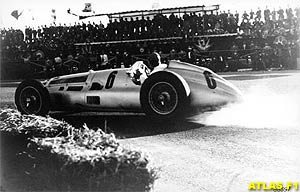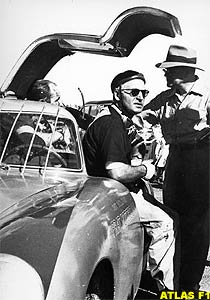
Atlas F1 Columnist
Karl Kling's death at the age of 92 two weeks ago was noted by many because he was the oldest Grand Prix driver. But the German post-war hero was much more than that. Atlas F1's Don Capps pays homage to the first Grand Prix driver whose hand he had the honor to shake
When Alfred Neubauer was looking for German drivers to take along on the Argentine excursion of 1951, Kling was partnered with Lang and local driver Juan Fangio. This would mark the beginning of a formal relationship with Daimler-Benz AG which would last throughout the remaining decades of his life.
The advent of the 300 SL "Gullwing" (W194) sports cars in 1952 saw Kling establish himself as leading driver on the Mercedes team. In the 1952 Mille Miglia, Kling was a sensation. He led at Rome only to finish second to the Ferrari of Giovanni Bracco. A stop requiring an over six-minute struggle with a knock-off hub which refused to budge, allowed Bracco into the lead, his margin of victory being four minutes and 32 seconds. At Berne two weeks later, Kling led a sweep of the first three places in the sports car race supporting the Swiss Grand Prix.
At Le Mans, Kling and Hans Klenk partnered in a W194 and were running in a very comfortable second place and biding their time for the leading Gordini to drop out when they were put out of the race when the generator failed. In early August, Kling drove an open version of the W194 in a 10-lap sports car event at the Nurburgring. Kling led until he slid on his own oil, allowing Lang past and remain in front to the checkered flag, Kling finishing second.
After installing "anti-buzzard bars" on their cars, the Mercedes team was soon back in the hunt, its effort led by Kling. Kling was pursuing his rival from May in Italy, Giovanni Bracco in a Ferrari. Kling hounded the Ferrari and forced Bracco to push his Ferrari too hard. North of Mexico City the differential in the Bracco Ferrari finally expired and Kling took the lead and won the race with teammate Lang in second place. His Mexican victory made Kling a national sporting hero in Germany. As Mercedes prepared its assault for the 1954 season, Kling joined the Alfa Romeo sports car team.
In 1954, Daimler-Benz returned to the Grand Prix wars. Kling was partnered with Juan Fangio and Hans Herrmann – a young driver emerging from the German racing scene. The first event the Mercedes team entered was the Grand Prix de l'Automobile Club de France at Reims. Fangio and Kling filled the first two positions on the front row of the grid. At the end, after 500 kilometers of racing, Fangio narrowly pipped Kling at the line by a mere tenth of a second. In later years, Kling would look upon this as a victory snatched from him by not only Fangio, but Neubauer.
The race at Reims and the Grosser Preis von Berlin, run on the AVUS circuit, were to be the highlights of Kling's Grand Prix career. The Berlin race was to be Kling's only Grand Prix victory, a Mercedes sweep of the first three positions Kling leading Fangio and Herrmann across the line.
In 1955, Kling ran in all the Grand Prix events that Mercedes entered with the exception of Monaco. He shared a fourth place in Argentina and was third in the British Grand Prix. However, it was in the new 300 SLR sports cars that Kling seemed destined for success. In preparation for the Mille Miglia, Kling did an amazing 30 laps of the nearly 1,600 kilometer route that the race would cover. After losing the 1952 event Kling was leaving nothing to chance in his bid for victory. Like teammate Fangio, Kling would run the race without a navigator. Kling was making an "maximum effort" and looking for a victory in the great Italian event. Alas, just a little over five hours into the race, Kling misjudged a corner and left the road, damaging the 300 SLR – and himself – enough to end his race then and there.
With the withdrawal of Mercedes from racing and the retirement of Alfred Neubauer as the manager of the competition department, Kling moved into the position vacated by Neubauer. The focus was now on rallying and long distance touring car events, the type of competition at which Kling excelled.
Kling eventually retired from Daimler-Benz and retired to a home on the Swiss side of Lake Constance. His later years were marred by the ill feelings and frustrations he felt during his racing years that he allowed to sour his view on many a person and the events of those days. It is sad to think that he ended his days as a bitter and resentful man.
However, there is another view of Karl Kling that I will always carry with me. I prefer to think of the charming, friendly man who took the time to shake the hand of a seven year-old and chat with him about racing for a few minutes. It was not a bitter or resentful Karl Kling who held aloft the W196 Streamliner bearing the racing number he carried at Reims, 20, and made a production of returning to the hands of its youthful owner. Karl Kling was the first Grand Prix driver whose hand I had the honor to shake.
Godspeed, Karl Kling.
The death of Karl Kling two weeks ago was noted by many solely because he carried the oldest "Grand Prix" driver's tag at the time of his death. Lost in the mists of time is that Kling was once the much more than a "Grand Prix" driver. In post-World War II Germany Karl Kling was the heir apparent to the great pre-war drivers – drivers such as Hans Stuck and Hermann Lang or Manfred von Brauchitsch.
 During the pre-war period, Kling was working his way up the racing ladder in national events, the War ending his hopes of reaching the top rung of that ladder, a place on the Mercedes Grand Prix team. When German motorsport began to revive after the War, Kling was among those who returned to the tracks to compete. Like many, he drove a BMW 328. Kling earned his post-war reputation first at the wheel of the Veritas sports cars, twice winning the German sports car championship.
During the pre-war period, Kling was working his way up the racing ladder in national events, the War ending his hopes of reaching the top rung of that ladder, a place on the Mercedes Grand Prix team. When German motorsport began to revive after the War, Kling was among those who returned to the tracks to compete. Like many, he drove a BMW 328. Kling earned his post-war reputation first at the wheel of the Veritas sports cars, twice winning the German sports car championship.
 Responding to earnest pleas of their Mexican agent, Daimler-Benz sent a team of the W194's to the 1952 Carrera Panamericana, the race which ran from literally one end of Mexico to the other. At first it appeared that the Mercedes effort was doomed: Lang struck a dog and heavily damaged his car; American John Fitch had one of his tyres throw a thread at speed, as did Kling and his navigator Hans Klenk. In addition, Kling struck a buzzard! The buzzard literally exploded a hole in the windshield in front of Klenk. Kling and Klenk were fortunate to emerge uninjured, much less alive.
Responding to earnest pleas of their Mexican agent, Daimler-Benz sent a team of the W194's to the 1952 Carrera Panamericana, the race which ran from literally one end of Mexico to the other. At first it appeared that the Mercedes effort was doomed: Lang struck a dog and heavily damaged his car; American John Fitch had one of his tyres throw a thread at speed, as did Kling and his navigator Hans Klenk. In addition, Kling struck a buzzard! The buzzard literally exploded a hole in the windshield in front of Klenk. Kling and Klenk were fortunate to emerge uninjured, much less alive.
 Later in May, Kling ran in the Nurburgring sports car race, initially being in the lead, but fading to fourth at the finish. Then came Le Mans. Kling and Andre Simon were running third when the decision was made to withdraw from the race. However, Kling and Fangio finished second in the Tourist Trophy and the Targa Florio, the latter being the last race that Daimler-Benz AG was to enter before withdrawing.
Later in May, Kling ran in the Nurburgring sports car race, initially being in the lead, but fading to fourth at the finish. Then came Le Mans. Kling and Andre Simon were running third when the decision was made to withdraw from the race. However, Kling and Fangio finished second in the Tourist Trophy and the Targa Florio, the latter being the last race that Daimler-Benz AG was to enter before withdrawing.
Please Contact Us for permission to republish this or any other material from Atlas F1.
|
Volume 9, Issue 14
Atlas F1 Exclusive
The French Connection: OPT Uncovered
Pizzonia: From Jungle to Jungle
Giancarlo Fisichella: Through the Visor
Articles
Karl Kling: An Appreciation
2003 Brazilian GP Preview
2003 Brazilian GP Preview
Between the Lakes
Brazilian GP Facts & Stats
Columns
The 700th GP Trivia Quiz
Bookworm Critique
On the Road
Elsewhere in Racing
The Weekly Grapevine
> Homepage |